The Bioalcohols Market is estimated to be valued at USD 14.4 billion in 2025 and is projected to reach USD 39.9 billion by 2035, registering a compound annual growth rate (CAGR) of 10.7% over the forecast period.
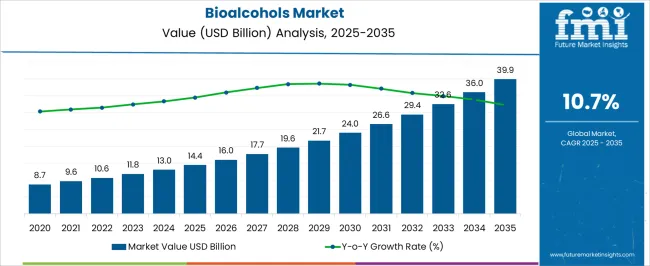
| Metric | Value |
|---|---|
| Bioalcohols Market Estimated Value in (2025 E) | USD 14.4 billion |
| Bioalcohols Market Forecast Value in (2035 F) | USD 39.9 billion |
| Forecast CAGR (2025 to 2035) | 10.7% |
The Bioalcohols market is witnessing strong growth, driven by the increasing demand for renewable and sustainable energy sources, alongside expanding applications in industrial, medical, and chemical sectors. Rising environmental concerns, stringent regulations on fossil fuel consumption, and government initiatives to reduce greenhouse gas emissions are supporting the adoption of bioalcohols. Technological advancements in fermentation processes, enzyme efficiency, and feedstock utilization have enhanced production capabilities while improving cost-effectiveness.
The integration of bioalcohols into fuels, pharmaceuticals, and personal care products has created diversified demand across multiple sectors. Sugarcane and other high-yield feedstocks are being leveraged to optimize production efficiency and reduce overall costs.
Investments in research and development for alternative feedstocks and bioprocessing techniques are further strengthening market dynamics As the global emphasis on sustainability and carbon-neutral solutions grows, bioalcohols are expected to see long-term adoption, with expanding applications in medical, industrial, and energy sectors reinforcing market growth.
The bioalcohols market is segmented by type, source, application, and geographic regions. By type, bioalcohols market is divided into Bioethanol, Bio Methanol, Biobutanol, Bio-BDO, and Others (Biopropanol, Bio-Glycerol, Etc.). In terms of source, bioalcohols market is classified into Sugarcane, Sugar Beet, Grains, Corn, and Others (Bio-Waste, Etc.). Based on application, bioalcohols market is segmented into Medical, Transportation, Infrastructure, Power Generation, and Others (Food & Beverage, Cosmetics & Personal Care, Etc.). Regionally, the bioalcohols industry is classified into North America, Latin America, Western Europe, Eastern Europe, Balkan & Baltic Countries, Russia & Belarus, Central Asia, East Asia, South Asia & Pacific, and the Middle East & Africa.
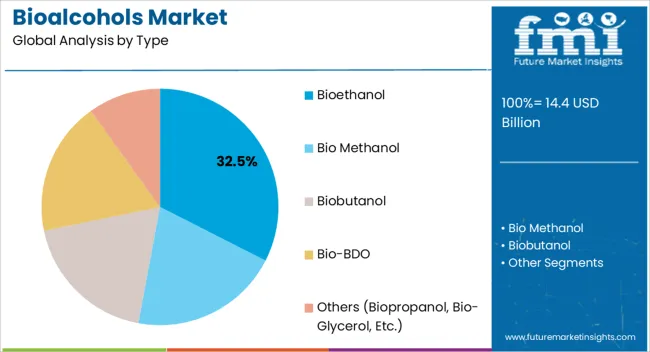
The bioethanol segment is projected to hold 32.5% of the Bioalcohols market revenue in 2025, establishing it as the leading type. Its dominance is being driven by extensive adoption in fuel blending, industrial applications, and pharmaceutical production. Bioethanol offers high energy efficiency, reduced environmental impact, and compatibility with existing infrastructure, making it a preferred choice for manufacturers and end users.
Advances in production processes, including enzymatic hydrolysis and fermentation optimization, have improved yield and reduced production costs. The ability to utilize diverse feedstocks and integrate with sustainable supply chains strengthens market appeal. Additionally, bioethanol is favored for medical and personal care applications due to its high purity and safety standards.
Continuous investment in research and development, coupled with increasing regulatory support for renewable energy and low-emission solutions, is further enhancing adoption With rising energy demand and sustainability initiatives, bioethanol is expected to maintain its leading position, supporting overall market expansion.
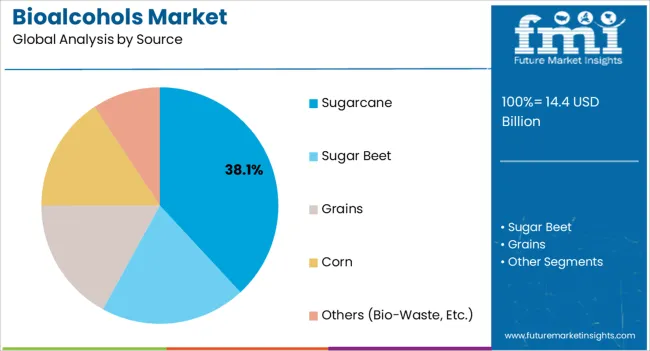
The sugarcane source segment is anticipated to account for 38.1% of the Bioalcohols market revenue in 2025, making it the leading feedstock. Its growth is being driven by high yield per hectare, cost-effectiveness, and established cultivation infrastructure in major producing regions. Sugarcane provides an efficient source of fermentable sugars, supporting large-scale bioalcohol production with consistent quality and energy efficiency.
Its availability and renewability reduce supply chain risks while ensuring scalability for industrial applications. Technological advancements in juice extraction, fermentation, and waste valorization have further enhanced production efficiency and sustainability. Government policies and subsidies in key producing countries incentivize sugarcane-based bioalcohol production, supporting market adoption.
The feedstock’s suitability for both energy and non-energy applications, such as pharmaceuticals and personal care, strengthens its market position As demand for renewable and low-emission bioalcohols rises globally, the sugarcane segment is expected to maintain leadership, enabling sustainable production and supporting market growth.
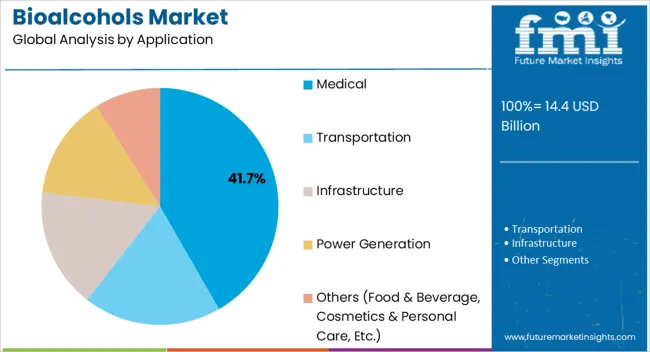
The medical application segment is projected to hold 41.7% of the Bioalcohols market revenue in 2025, establishing it as the leading application area. Growth in this segment is being driven by the widespread use of bioalcohols in pharmaceuticals, sanitizers, antiseptics, and laboratory reagents. High purity, biocompatibility, and regulatory compliance make bioalcohols suitable for medical and healthcare applications.
Increasing awareness of hygiene, infection control, and safety standards is further supporting adoption, particularly in hospitals, clinics, and research laboratories. Technological advancements in purification processes and quality control ensure consistent performance and compliance with global pharmacopoeia standards. Bioalcohols also serve as key intermediates in drug synthesis and formulation, expanding their application scope.
Rising investments in healthcare infrastructure, pharmaceutical manufacturing, and research initiatives are reinforcing demand As global healthcare systems continue to emphasize safety, efficiency, and sustainable practices, the medical application segment is expected to remain the primary driver of growth in the Bioalcohols market.
According to the latest market survey conducted by Future Market Insights, the global bio alcohols market is expected to reach a market valuation of US$ 10.64 Bn by 2025, and further projected to expand with a CAGR of 10.7% during the 2025 – 2035. The market is anticipated to top a valuation of US$ 29.4 Bn by the end of the forecast period.
| Market Size 2025 | US$ 10.64 Bn |
| Market Size 2035 | US$ 29.40 Bn |
| Value CAGR (2025-2035) | 10.7% |
| Collective Value Share: Top 3 Countries (2025E) | 50% – 55% |
Bioalcohols are simply alcohols derived from biomass or biological resources. The most well-known and widely produced bio alcohol is bioethanol which is considered a primary substitute fuel for spark ignition engines. Bioalcohols are commonly produced from a variety of biomass sources, such as grains, food waste, residues, and lignocellulosic crops. Bio alcohols are typically identified as first generation and second generation.
The first generation of bio alcohols is made from crops whereas, second generation bio alcohols are made from lignocellulosic biomass, such as forestry or agricultural waste.
Bio-alcohol is a bio-energy substitute that may also be used in energy-related applications such as power generation. Its applications in trucks, buses, airplanes, and fuel cells are currently driving its demand. Bio-alcohol can be blended with petroleum products in the replacement of hydrocarbons, which will help extend petroleum supplies and improve global fuel security. Bio-alcohol is also driving growth by its biodegradability and lower toxicity than fossil fuels.
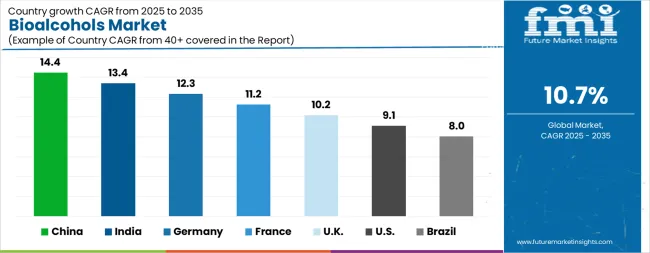
| Country | CAGR |
|---|---|
| China | 14.4% |
| India | 13.4% |
| Germany | 12.3% |
| France | 11.2% |
| UK | 10.2% |
| USA | 9.1% |
| Brazil | 8.0% |
The Bioalcohols Market is expected to register a CAGR of 10.7% during the forecast period, exhibiting varied country level momentum. China leads with the highest CAGR of 14.4%, followed by India at 13.4%. Developed markets such as Germany, France, and the UK continue to expand steadily, while the USA is likely to grow at consistent rates. Brazil posts the lowest CAGR at 8.0%, yet still underscores a broadly positive trajectory for the global Bioalcohols Market. In 2024, Germany held a dominant revenue in the Western Europe market and is expected to grow with a CAGR of 12.3%. The USA Bioalcohols Market is estimated to be valued at USD 5.2 billion in 2025 and is anticipated to reach a valuation of USD 12.4 billion by 2035. Sales are projected to rise at a CAGR of 9.1% over the forecast period between 2025 and 2035. While Japan and South Korea markets are estimated to be valued at USD 733.4 million and USD 471.6 million respectively in 2025.
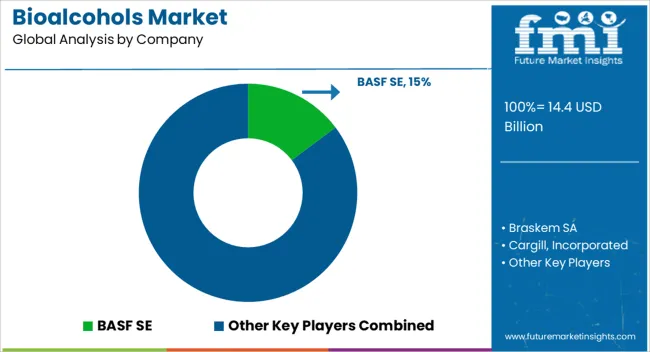
| Item | Value |
|---|---|
| Quantitative Units | USD 14.4 Billion |
| Type | Bioethanol, Bio Methanol, Biobutanol, Bio-BDO, and Others (Biopropanol, Bio-Glycerol, Etc.) |
| Source | Sugarcane, Sugar Beet, Grains, Corn, and Others (Bio-Waste, Etc.) |
| Application | Medical, Transportation, Infrastructure, Power Generation, and Others (Food & Beverage, Cosmetics & Personal Care, Etc.) |
| Regions Covered | North America, Europe, Asia-Pacific, Latin America, Middle East & Africa |
| Country Covered | United States, Canada, Germany, France, United Kingdom, China, Japan, India, Brazil, South Africa |
| Key Companies Profiled | BASF SE, Braskem SA, Cargill, Incorporated, DuPont de Nemours, Inc., Fulcrum BioEnergy, Inc., Genomatica, Inc., Harvest Power, Koninklijke DSM N.V., Lallemand Inc., Mitsubishi Chemical Holdings Corporation, PTT Global Chemical Public Company Limited, and Valero Marketing, Supply Company |
The global bioalcohols market is estimated to be valued at USD 14.4 billion in 2025.
The market size for the bioalcohols market is projected to reach USD 39.9 billion by 2035.
The bioalcohols market is expected to grow at a 10.7% CAGR between 2025 and 2035.
The key product types in bioalcohols market are bioethanol, bio methanol, biobutanol, bio-bdo and others (biopropanol, bio-glycerol, etc.).
In terms of source, sugarcane segment to command 38.1% share in the bioalcohols market in 2025.






Our Research Products

The "Full Research Suite" delivers actionable market intel, deep dives on markets or technologies, so clients act faster, cut risk, and unlock growth.

The Leaderboard benchmarks and ranks top vendors, classifying them as Established Leaders, Leading Challengers, or Disruptors & Challengers.

Locates where complements amplify value and substitutes erode it, forecasting net impact by horizon

We deliver granular, decision-grade intel: market sizing, 5-year forecasts, pricing, adoption, usage, revenue, and operational KPIs—plus competitor tracking, regulation, and value chains—across 60 countries broadly.

Spot the shifts before they hit your P&L. We track inflection points, adoption curves, pricing moves, and ecosystem plays to show where demand is heading, why it is changing, and what to do next across high-growth markets and disruptive tech

Real-time reads of user behavior. We track shifting priorities, perceptions of today’s and next-gen services, and provider experience, then pace how fast tech moves from trial to adoption, blending buyer, consumer, and channel inputs with social signals (#WhySwitch, #UX).

Partner with our analyst team to build a custom report designed around your business priorities. From analysing market trends to assessing competitors or crafting bespoke datasets, we tailor insights to your needs.
Supplier Intelligence
Discovery & Profiling
Capacity & Footprint
Performance & Risk
Compliance & Governance
Commercial Readiness
Who Supplies Whom
Scorecards & Shortlists
Playbooks & Docs
Category Intelligence
Definition & Scope
Demand & Use Cases
Cost Drivers
Market Structure
Supply Chain Map
Trade & Policy
Operating Norms
Deliverables
Buyer Intelligence
Account Basics
Spend & Scope
Procurement Model
Vendor Requirements
Terms & Policies
Entry Strategy
Pain Points & Triggers
Outputs
Pricing Analysis
Benchmarks
Trends
Should-Cost
Indexation
Landed Cost
Commercial Terms
Deliverables
Brand Analysis
Positioning & Value Prop
Share & Presence
Customer Evidence
Go-to-Market
Digital & Reputation
Compliance & Trust
KPIs & Gaps
Outputs
Full Research Suite comprises of:
Market outlook & trends analysis
Interviews & case studies
Strategic recommendations
Vendor profiles & capabilities analysis
5-year forecasts
8 regions and 60+ country-level data splits
Market segment data splits
12 months of continuous data updates
DELIVERED AS:
PDF EXCEL ONLINE

Thank you!
You will receive an email from our Business Development Manager. Please be sure to check your SPAM/JUNK folder too.
Chat With
MaRIA